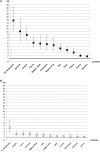Influenza vaccination coverage among high-risk groups in 11 European countries
- PMID: 21750011
- PMCID: PMC3402715
- DOI: 10.1093/eurpub/ckr094
Influenza vaccination coverage among high-risk groups in 11 European countries
Abstract
Background: National vaccination coverage rates for individuals at increased risk of influenza-related complications represent a useful public health indicator of preparedness. We compared European countries regarding (i) vaccination coverage among high-risk groups and (ii) the likelihood that high-risk individuals reported influenza vaccination compared with those at lower risk.
Methods: We used data from the Survey of Health, Ageing and Retirement in Europe (SHARE) collected in 2004-05. Adults aged ≥ 50 years from 11 countries provided self-reports of an influenza vaccination in the previous year (n = 16,913). We defined four high-risk groups (age ≥ 65 years, presence of vascular disease, chronic lung disease or diabetes) and calculated vaccination coverage with 95% confidence intervals for each country. Country-specific multivariable logistic regression was used to estimate odds ratios (ORs) for membership in a high-risk group and vaccination.
Results: The Netherlands had the highest influenza vaccination coverage in high-risk groups (≥ 75% in any group) while Greece had the lowest (<27% in any group). Older age was positively associated with report of vaccination in all countries, but the strength of this association varied from an OR of <2 (Germany) to >13 (The Netherlands). The ORs for the chronic disease groups was ≥ 4 for The Netherlands and were considerably lower (and often not statistically significant) for the other countries.
Conclusion: Influenza vaccination coverage among high-risk groups varies considerably between European countries. Our findings highlight potential opportunities for reducing influenza-related complications through support for vaccination programs that target high-risk individuals more effectively.
Figures



Similar articles
-
How close are countries of the WHO European Region to achieving the goal of vaccinating 75% of key risk groups against influenza? Results from national surveys on seasonal influenza vaccination programmes, 2008/2009 to 2014/2015.Vaccine. 2018 Jan 25;36(4):442-452. doi: 10.1016/j.vaccine.2017.12.019. Epub 2017 Dec 26. Vaccine. 2018. PMID: 29287683 Free PMC article.
-
Disparities in influenza vaccination coverage rates by target group in five European countries: trends over seven consecutive seasons.Infection. 2009 Oct;37(5):390-400. doi: 10.1007/s15010-009-8467-y. Epub 2009 Sep 18. Infection. 2009. PMID: 19768382
-
Vaccination coverage rates in eleven European countries during two consecutive influenza seasons.J Infect. 2009 Jun;58(6):446-58. doi: 10.1016/j.jinf.2009.04.001. Epub 2009 Apr 17. J Infect. 2009. PMID: 19446340
-
Seasonal influenza and vaccination coverage.Vaccine. 2010 Sep 7;28 Suppl 4:D33-44. doi: 10.1016/j.vaccine.2010.08.027. Vaccine. 2010. PMID: 20713259 Review.
-
The influenza landscape and vaccination coverage in older adults during the SARS-Cov-2 pandemic: data from Several European Countries and Israel.Expert Rev Respir Med. 2024 Mar-Apr;18(3-4):69-84. doi: 10.1080/17476348.2024.2340470. Epub 2024 May 8. Expert Rev Respir Med. 2024. PMID: 38652642 Review.
Cited by
-
Trajectories of seasonal influenza vaccine uptake among French people with diabetes: a nationwide retrospective cohort study, 2006-2015.BMC Public Health. 2019 Jul 9;19(1):918. doi: 10.1186/s12889-019-7209-z. BMC Public Health. 2019. PMID: 31288768 Free PMC article.
-
Flu vaccination among patients with diabetes: motives, perceptions, trust, and risk culture - a qualitative survey.BMC Public Health. 2018 May 2;18(1):569. doi: 10.1186/s12889-018-5441-6. BMC Public Health. 2018. PMID: 29716565 Free PMC article.
-
Aging, cytomegalovirus (CMV) and influenza vaccine responses.Hum Vaccin Immunother. 2016 Mar 3;12(3):682-90. doi: 10.1080/21645515.2015.1105413. Hum Vaccin Immunother. 2016. PMID: 26588038 Free PMC article. Review.
-
Knowledge, attitudes, and practices (KAP) toward seasonal influenza vaccine among college students under the COVID-19 pandemic in South China.Immun Inflamm Dis. 2023 Dec;11(12):e1110. doi: 10.1002/iid3.1110. Immun Inflamm Dis. 2023. PMID: 38156389 Free PMC article.
-
The intentions to get vaccinated against influenza and actual vaccine uptake among diabetic patients in Ningbo, China: identifying motivators and barriers.Hum Vaccin Immunother. 2021 Jan 2;17(1):106-118. doi: 10.1080/21645515.2020.1761201. Epub 2020 May 27. Hum Vaccin Immunother. 2021. PMID: 32460620 Free PMC article.
References
-
- World Health Organization. Influenza (Seasonal). Fact Sheet N° 211. Available at: http://www.who.int/mediacentre/factsheets/fs211/en (4 May 2010 date last accessed)
-
- Szucs T. The socio-economic burden of influenza. J Antimicrob Chemother. 1999;44:11–5. - PubMed
-
- Keech M, Scott AJ, Ryan PJ. The impact of influenza and influenza-like illness on productivity and healthcare resource utilization in a working population. Occup Med. 1998;48:85–90. - PubMed
-
- Nicoll A, Ciancio B, Tsolova S, Blank P, Yilmaz C. The scientific basis for offering seasonal influenza immunisation to risk groups in Europe. Euro Surveill. 2008;13:7. - PubMed
-
- World Health Organization. Resolution of the World Health Assembly. Prevention and control of influenza pandemics and annual epidemics. World Health Assembly. 2003 WHA56.19.
Publication types
MeSH terms
Substances
Grants and funding
LinkOut - more resources
Full Text Sources
Medical

